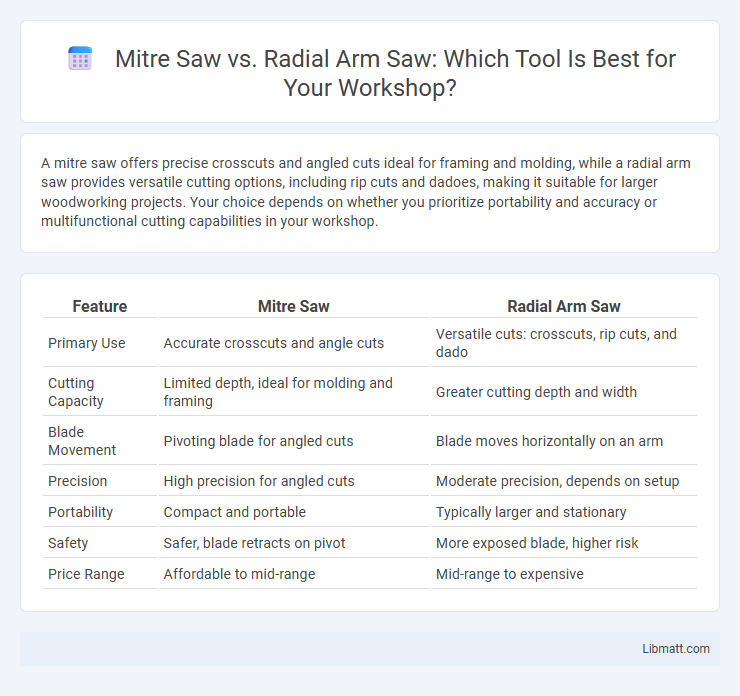A mitre saw offers precise crosscuts and angled cuts ideal for framing and molding, while a radial arm saw provides versatile cutting options, including rip cuts and dadoes, making it suitable for larger woodworking projects. Your choice depends on whether you prioritize portability and accuracy or multifunctional cutting capabilities in your workshop.
Table of Comparison
| Feature | Mitre Saw | Radial Arm Saw |
|---|---|---|
| Primary Use | Accurate crosscuts and angle cuts | Versatile cuts: crosscuts, rip cuts, and dado |
| Cutting Capacity | Limited depth, ideal for molding and framing | Greater cutting depth and width |
| Blade Movement | Pivoting blade for angled cuts | Blade moves horizontally on an arm |
| Precision | High precision for angled cuts | Moderate precision, depends on setup |
| Portability | Compact and portable | Typically larger and stationary |
| Safety | Safer, blade retracts on pivot | More exposed blade, higher risk |
| Price Range | Affordable to mid-range | Mid-range to expensive |
Introduction to Mitre Saws and Radial Arm Saws
Mitre saws are precision tools designed for making accurate crosscuts and angled cuts in wood, commonly used in carpentry and framing projects. Radial arm saws feature a versatile arm extending over the worktable, enabling a variety of cuts such as dados, rip cuts, and miters. Understanding the functions of these saws helps you select the right equipment for your woodworking needs, ensuring accuracy and efficiency.
Key Differences Between Mitre Saws and Radial Arm Saws
Mitre saws feature a fixed arm with a rotating circular blade that cuts precise angled crosscuts, ideal for molding and framing tasks, while radial arm saws have a horizontal arm allowing the blade to slide forward and backward for versatile ripping, crosscutting, and dado cuts. Mitre saws prioritize accuracy and ease of use with limited movement, whereas radial arm saws offer greater flexibility but require more skill to operate safely and precisely. Your choice depends on whether you need specialized angled cuts or multi-functional ripping and crosscutting capabilities.
Cutting Capabilities and Versatility
Mitre saws excel in precision miter and bevel cuts, making them ideal for framing, molding, and trim work with angled cuts up to 45 degrees or more. Radial arm saws offer greater versatility, capable of performing crosscuts, rip cuts, dadoes, and even taper cuts due to their adjustable arm and blade positioning. Your choice depends on whether you prioritize specialized angled cutting accuracy (mitre saw) or a broader range of cutting operations (radial arm saw) for your woodworking projects.
Accuracy and Precision Comparison
Mitre saws offer superior accuracy and precision for making angled cuts due to their fixed arm and adjustable blade settings, ensuring consistent results with minimal user error. Radial arm saws provide versatility but can sacrifice precision because of their sliding arm mechanism, which may introduce slight variations in blade alignment over time. For tasks requiring exact miters and clean crosscuts, mitre saws are generally the preferred choice.
Size, Portability, and Workspace Requirements
Mitre saws are generally more compact and lightweight, making them highly portable for job sites or small workshops, while radial arm saws are larger and bulkier, requiring a more permanent space in your workspace. The mitre saw's smaller footprint allows it to fit comfortably on benchtops or portable stands, whereas radial arm saws demand a substantial work surface and floor space due to their extended arm and sliding mechanism. Your choice depends on the available workspace and the need for mobility, with mitre saws better suited for tight areas and easier transport.
Safety Features and User Considerations
Mitre saws prioritize safety with features like blade guards, electric brakes, and secure clamping systems to minimize kickback and accidental contact. Radial arm saws require careful user handling due to exposed blades and potential for blade drift, making protective gear and proper training essential. Your choice should consider your skill level and workspace safety setup to ensure effective and secure operation.
Typical Use Cases and Applications
Mitre saws are ideal for precise crosscuts, angled cuts, and trim work commonly used in woodworking, framing, and cabinetry projects where accuracy and clean edges are essential. Radial arm saws excel in versatile cutting tasks such as ripping, crosscutting, and dado cuts, making them suitable for larger woodworking projects and general carpentry requiring multiple types of cuts with a single tool. Both tools provide essential functions but differ in their optimal applications based on cutting requirements and project complexity.
Maintenance and Longevity
Mitre saws require minimal maintenance with periodic blade sharpening and lubrication of moving parts, ensuring a longer lifespan through consistent care. Radial arm saws demand more frequent adjustments and careful handling to maintain alignment and prevent wear on the arm mechanism, directly affecting their durability. Choosing a mitre saw often results in lower maintenance effort and prolonged tool life compared to the more complex upkeep of radial arm saws.
Cost and Value for Money
Mitre saws generally offer better value for money due to their lower cost, ease of use, and precision for common woodworking tasks. Radial arm saws tend to be more expensive and bulky, with maintenance costs that can reduce long-term value for typical DIY projects. For budget-conscious buyers prioritizing accuracy and portability, mitre saws are often the more cost-effective option.
Choosing the Right Saw for Your Needs
When choosing between a mitre saw and a radial arm saw, consider the precision and types of cuts you need. Mitre saws excel in making accurate crosscuts and angled cuts, ideal for trim work and framing, while radial arm saws offer versatility with rip cuts, crosscuts, and dadoes but require more space and skill to operate safely. Your decision should align with your project demands, workspace constraints, and skill level to ensure the best efficiency and safety.
Mitre saw vs radial arm saw Infographic

 libmatt.com
libmatt.com